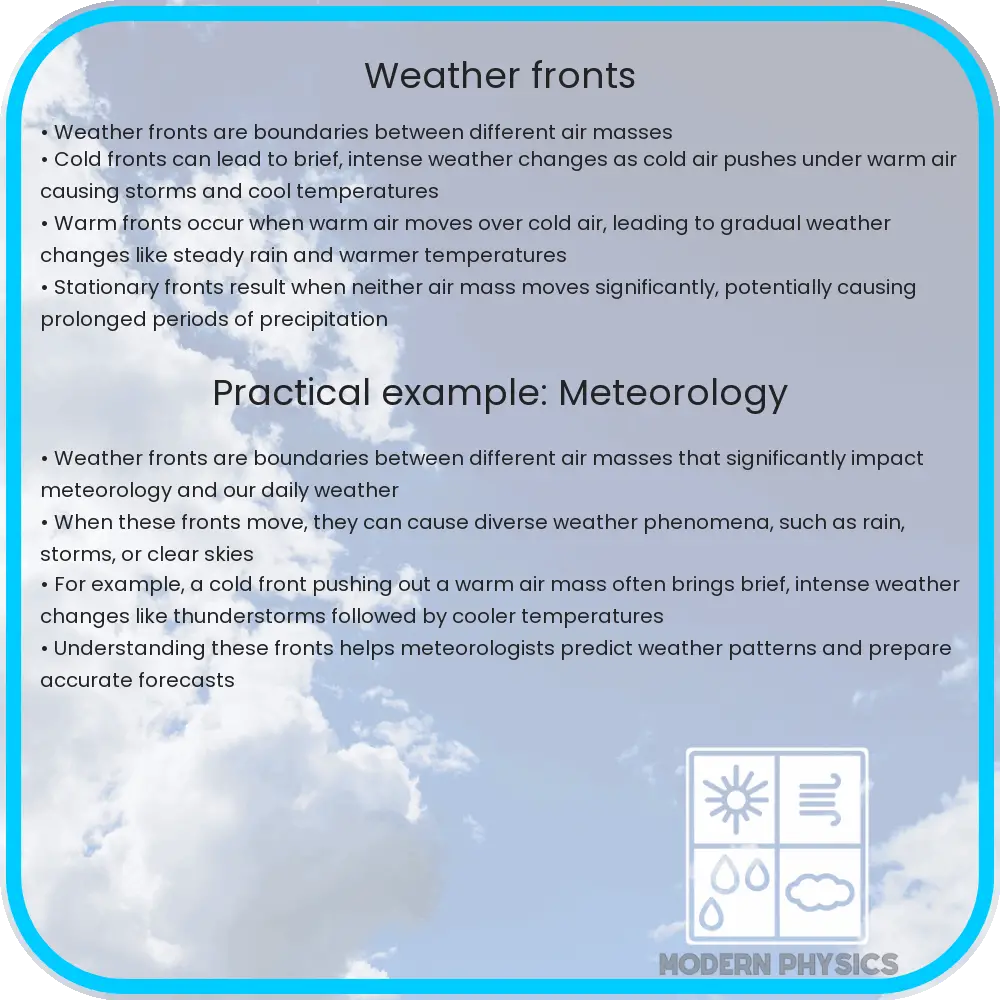A detailed exploration of weather fronts, their formation, effects, and methods for accurate prediction to enhance weather forecasting.

Understanding Weather Fronts: Formation, Effects, and Prediction
Weather fronts are critical in shaping the short-term weather patterns we experience daily. These fronts are essentially boundaries that separate two distinct masses of air with different densities, temperatures, and humidity levels. Understanding how these fronts form and their impacts can provide valuable insight into weather prediction and preparation.
Formation of Weather Fronts
The formation of weather fronts is primarily influenced by the interactions between different air masses. An air mass is a large body of air that has uniform temperature and humidity characteristics. When two contrasting air masses meet, they create a front. There are four main types of fronts:
- Cold Front: This occurs when a colder air mass moves towards and under a warmer air mass, lifting the warm air. This is because cold air is denser than warm air.
- Warm Front: In contrast to a cold front, a warm front forms when a warm air mass moves towards and over a colder air mass, sliding over the cooler air.
- Stationary Front: When neither of the air masses is strong enough to replace the other, they sort of ‘stall,’ leading to a stationary front. This can lead to prolonged periods of cloudy and wet weather.
- Occluded Front: This type of front forms during the maturation of a cyclonic system, where a cold front overtakes a warm front and forces the warm air upward between two masses of cooler air.
Effects of Weather Fronts
The interaction between different air masses at these fronts leads to most of the weather changes we observe:
- Temperature Changes: As a front passes, noticeable changes in temperature can occur within a short period. Cold fronts generally bring a sudden drop in temperature, while warm fronts may cause a gradual increase.
- Precipitation: Fronts are often associated with various forms of precipitation. Warm fronts typically bring light, steady rain as the warm moist air slowly rises over the cold air. In contrast, cold fronts can lead to more intense and sometimes violent weather phenomena like thunderstorms or hail, as the warm air is abruptly forced upwards.
- Wind Changes: The clash between different air masses can lead to sudden changes in wind direction and speed. These changes are often most pronounced near cold fronts where the displacing cold air accelerates the wind.
- Cloud Formation: The type of clouds formed can often indicate the type of front. For example, warm fronts tend to produce high-level clouds like cirrus, which gradually change into stratus as the front nears. Cold fronts, however, are more likely to generate towering cumulus or cumulonimbus clouds leading to heavier precipitation.
Prediction of Weather Fronts
Predicting the arrival and impact of weather fronts is a critical component of meteorological science. Advances in satellite and radar technology have significantly enhanced the ability to track these air masses as they move. Meteorologists use a variety of data inputs and models to predict the behavior of fronts:
- Observation Data: Data collected from weather stations, buoys, and aircraft provide real-time information on temperature, pressure, humidity, and wind, which are crucial for identifying fronts.
- Imaging: Satellite and radar imaging help in visualizing the movement of clouds and precipitation patterns associated with fronts.
- Computer Models: These models simulate the atmosphere’s behavior based on current conditions and known physical laws, predicting how fronts will move and develop.
With these tools, meteorologists are better equipped to forecast the weather changes associated with fronts, allowing for more timely weather warnings and preparedness activities.
Challenges in Predicting Weather Fronts
Despite significant technological advancements, predicting weather fronts still poses several challenges:
- Complexity of Interactions: The atmosphere is a dynamic system, where slight changes can alter the development and intensity of fronts. This makes precise predictions difficult.
- Resolution of Models: While computer models are invaluable, their accuracy depends on the resolution, which may not capture fine-scale atmospheric processes.
- Limitations of Data: Observational data may be sparse, especially over oceans or remote areas, leading to gaps in understanding the full picture of the atmospheric conditions.
Importance of Accurate Weather Predictions
Accurate predictions of weather fronts are more than just a matter of convenience; they are crucial for:
- Safety: Timely and accurate weather predictions can save lives by forewarning communities of severe weather, allowing them to take necessary precautions.
- Economic Impact: Agriculture, transportation, and many other sectors depend heavily on weather forecasts to minimize losses and optimize operations.
- Research and Development: Continuous improvements in meteorological techniques and tools rely on understanding past weather phenomena, including the behavior of fronts.
As technology evolves, so does the precision of weather forecasting, highlighting the need for ongoing research and development in meteorology.
Conclusion
Understanding and predicting weather fronts is a cornerstone of meteorology, essential for preparing for the myriad of climatic conditions we face. From the basic dynamics of cold and warm fronts to the intricate use of satellite imagery and computational models, meteorologists strive to refine their forecasts to provide timely and accurate weather information. While challenges persist in prediction accuracy due to the complex nature of atmospheric processes, ongoing advancements in technology and methodology continue to enhance our capability to predict and prepare for weather conditions more effectively. This not only aids in daily planning and safety measures but also contributes substantially to managing long-term climate-related challenges. Recognizing the importance of these predictions helps us appreciate the intricate dynamics of weather and the skilled work of meteorologists around the globe.
